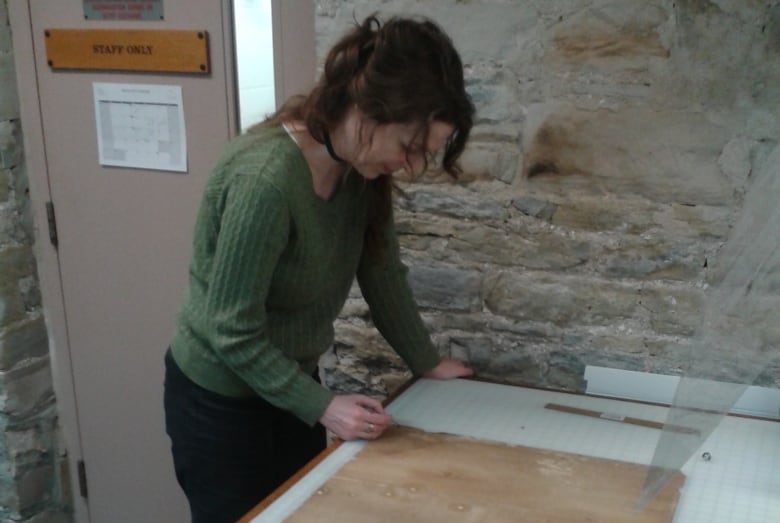
51:07Retelling history from Indigenous perspectives
A rare Indigenous perspective of the Battle of the Little Bighorn is discovered in a donation to the Peel Art Gallery and Museum. It helps us consider a significant event in history from an Indigenous perspective, something that organizations like Festival du Voyageur in Manitoba and the Haida Gwaii Institute in British Columbia are also doing in their work to re-educate and re-tell the history of Turtle Island. Broadcast date: April 2, 2022/ April 5, 2022 51:07
When Samantha Thompson read the first line of a long-lost letter, she knew that her work to authenticate and transcribe the mysterious set of rolled-up documents, packed away for some future archivist, was worth it.
“I remember where I was sitting at my desk and I started reading: ‘I was born in Montana, my father died when I was four years old and so I lived with my mother and sister and my grandparents and my uncle,’ and my heart started beating faster,” said Thompson, an archivist at the Peel Art Gallery Museum and Archives in Brampton, Ont.
A few months earlier, Thompson had been going through one of 60 boxes donated to the museum. She came across several pages of thick paper — on one was a detailed watercolour painting, and the others were made up of what looked like two letters, one lengthy and the other short.
While there were some English names like “Reno,” “Custer” and “Montana,” the letter was written in Old German, a rare dialect that fell out of use around the Second World War.
“Right away we had this mystery. Why is somebody writing in Old German about what seems to relate to a possibly significant event in U.S. history?” Thompson told Rosanna Deerchild in an interview for Unreserved.
As luck would have it, a colleague’s mother could read the rare dialect and agreed to help with the translation. It took several months, but when it finally arrived in January 2020, Thompson was looking at a first-person account of one of the most significant battles in U.S. history: the Battle of the Little Bighorn.

A written account from Standing Bear
The account comes from Lakota leader Standing Bear, who was just 17 years old on June 25, 1876, when Lt.-Col. George A. Custer and his troops descended on the Lakota and their Cheyenne relatives who were camping along the Little Bighorn River in Montana.
That battle, known by the Lakota as the Battle of Greasy Grass, is celebrated as a victory for Indigenous people who stood their ground and resisted their forced relocation onto reservations. Its anniversary is a tribally recognized holiday in the United States, with many ceremonies beginning on or ending June 25.
In Standing Bear’s letter, written in the early 1930s, he tells of how his uncles took him hunting as a boy, and how they would often swim across the Missouri River. One day, his uncle told him they would attend a Sun Dance near the Rosebud River, and that legendary Hunkpapa Lakota leader, Sitting Bull, encouraged many people to attend.
Standing Bear says he witnessed this ceremony and included a painting of Sitting Bull leading the Sun Dance with his letter. The sacred ceremony, according to Standing Bear, lasted three or four days. One more day passed, and that’s when Custer’s men arrived.
Then I heard a man shouting that the soldiers were coming. They had shot a boy that was on his way to get our horses. I ran back and saw that another man was bringing our horses, I sprang onto a horse but I didn’t have time to dress, I had only my shirt but no shoes. I rode with my uncle in the direction toward Reno when on the hill we saw Custer advancing. Before we got closer we saw hundreds upon hundreds of our people around us. A few of them had guns and most of them had bows and arrows.
– Standing Bear, in the letter he dictated in the 1930s
Standing Bear’s account of that battle offers a rare written account from an Indigenous point of view. While there are many oral accounts of these types of historic events, very few written accounts are known to archivists. It’s one of the reasons Thompson wanted to see the documents repatriated to the Lakota community as soon as possible.
“This was a voice that our archives team unanimously agreed needed to go home. It would speak to us better in its own community, and there was never any doubt about that,” Thompson said.

Getting the documents home
A google search introduced Thompson to the work of Tawa Ducheneaux, an archivist with the Oglala Lakota College Woksape Tipi Archives and Tribal Repository in Kyle, S.D. Thompson sent her digital images of the letters and the illustration of Sitting Bull shortly after receiving the translation.
Ducheneaux says she immediately recognized the image as being Plains Ledger art, a style created by northern and southern plains Indigenous people as a way of telling story. She welcomed the opportunity to add it to the Woksape Tipi collections.

“When you think about the winter counts — the visual ways that we would tell stories through the pictorial depictions in winter counts and what became known as ledger art and the revival of ledger art over the last number of decades — it’s really powerful. We are here, we are alive, we’re telling stories,” she said.
It would take nearly two years of cross-border bureaucracy and shipping challenges, exacerbated by a global pandemic, before the letter and painting could be received. They are temporarily being held at the Journey Museum and Learning Centre in Rapid City, S.D.
That’s where Arthur Amiotte, the great-grandson of Standing Bear, received them during a small gathering on Dec. 3, 2021.

By this time, Thompson knew that the reason Standing Bear’s account of the Battle of the Little Bighorn was written in Old German was because Standing Bear had dictated it to his wife, Louise Standing Bear, whose first language was German. The last lines of the letter read:
Honoured Sir,
I have written what my husband told me and hope you can find someone to translate it. You will notice the mistakes but I have been here for 42 years and have no one to whom I can speak in German.
Respectfully,
Louise Standing Bear
As Amiotte unwrapped the precious letter in December, he offered further analysis on the correspondence.
“[Standing Bear] spoke Lakota directly to [Louise Standing Bear] and then she translated it into German. Since that was her first language and it was an academic language then she could, according to her world view of expression through writing, do a more articulate interpretation of what he was telling,” Amiotte said in a video captured by staff at the Journey Museum and Learning Center.
Standing Bear and Louise Standing Bear
Standing Bear met Louise Standing Bear in Vienna in 1890, during his tour with Buffalo Bill’s Wild West shows — theatrical productions depicting romanticized images of the American West.
Standing Bear was recovering in Vienna after learning of the death of his first wife and baby daughter, who were killed at Wounded Knee, a massacre of nearly 300 Lakota people by soldiers of the U.S. Army on Dec. 29, 1890.

Eventually the two grew closer, and in 1891 Louise Standing Bear, along with her mother and father, immigrated to the United States and settled at Pine Ridge Reservation. The couple had a son who died in infancy, and three daughters, one of whom was Amiotte’s grandmother, who shared many stories of the couple.
“They were such a team,” said Amiotte, who explained that they had to face a lot of judgment and hardships over their marriage.
“Even the social scene at Pine Ridge was against the marriage. The priests at Holy Rosary Mission and government officials just thought it was horrendous that a white woman, she could marry an Indian man,” Amiotte said.
“And secondly, the fact that she was Austrian, German, during World War One — there was a lot of anti-German, anti-Austrian, European sentiment. But they managed to live through it.”
WATCH | Chief Sitting Bull flees American forces and makes his way to Saskatchewan:
Jonny shares the story of how Chief Sitting Bull, fleeing from American forces after the Battle of the Little Bighorn, sought refuge in Willow Bunch, SK. 1:10
From Pine Ridge Reservation to Brampton
Thompson’s best guess as to how the letter ended up in Brampton is that it was a response to an inquiry by William Perkins Bull. Bull, who died in 1948, was a local historian in Brampton whose work forms the core of the local history collection at the Peel Art Gallery Museum and Archives.
Thompson says that because Bull was a prolific letter writer and interested in oral accounts, she believes he wrote to someone on Pine Ridge Reservation to learn more about the Battle of Little Bighorn and Sitting Bull in particular.
“We haven’t found the smoking gun yet in the collection where we can see him writing to somebody in South Dakota, but because Standing Bear says in his letter, ‘you’ve asked me whether Sitting Bull was in Custer’s battle, I’m getting back to you with this illustration of the Sun Dance which is where I saw him, but I don’t know if he was in the battle’.”
A rare piece of history
There is dispute among some historians around Sitting Bull’s role in the Battle of the Little Bighorn, which is one of the reasons Standing Bear’s painting of Sitting Bull at the Sun Dance is particularly powerful, according to Ducheneaux.
“Sitting Bull was in his 60s by this time and … he was providing guidance. So from his descendent that I’ve spoken with, he sat out, but he gave direction, and that direction also is reflected in this drawing,” she said.

It’s not yet known if Standing Bear’s drawing will be published due to concerns about its depiction of sacred items associated with the Sun Dance, but it will be available for viewing at the Woksape Tipi in the coming months.
As for Standing Bear’s written account, Ducheneaux says such text is very rare, especially among the Lakota people where it is customary to burn a relative’s possessions after they die.
“Sometimes it’s an entire home — everything, especially if that Elder was living alone at that time. That is part of that ceremony and so these physical, you know, examples of the story are often not retained, they’re passed orally. So this indeed is an unusual example,” she said.
Ducheneaux says she feels an incredible responsibility to care for items like these and preserve them for future generations, and that their repatriation is an act of reconciliation.
“When there’s this recognition and understanding that there’s value in returning something to the community of origin, it’s just so profoundly inspiring and positive,” she said.
Thompson and Ducheneaux agree that there are other voices from the past waiting to be discovered in archives across Turtle Island.
“We always need more archivists and more time. And, you know, the accession that this was found in was 60 boxes, you know, 60 large boxes. So when we have that time, we can allow these voices to speak again,” said Thompson.














